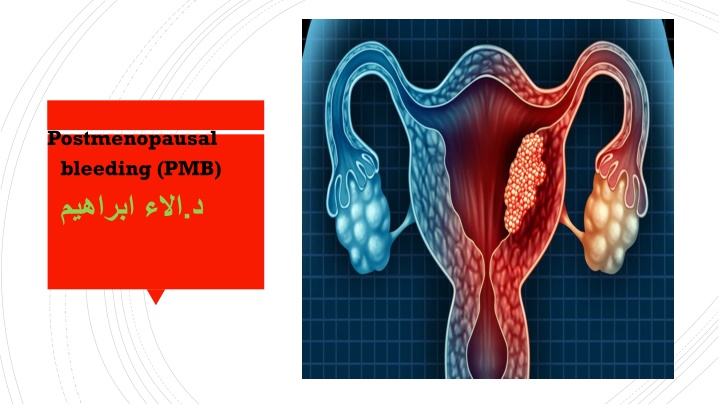
Postmenopausal Bleeding: Causes and Management
Explore the causes, risk factors, and management of postmenopausal bleeding (PMB) in women, including common conditions like endometrial cancer and hormonal therapy. Learn about the stepwise approach to diagnosing PMB and identifying associated risks through history, examination, and more.
Download Presentation

Please find below an Image/Link to download the presentation.
The content on the website is provided AS IS for your information and personal use only. It may not be sold, licensed, or shared on other websites without obtaining consent from the author. If you encounter any issues during the download, it is possible that the publisher has removed the file from their server.
You are allowed to download the files provided on this website for personal or commercial use, subject to the condition that they are used lawfully. All files are the property of their respective owners.
The content on the website is provided AS IS for your information and personal use only. It may not be sold, licensed, or shared on other websites without obtaining consent from the author.
E N D
Presentation Transcript
Postmenopausal bleeding (PMB) .
Definition of PMB. Causes of PMB. Objective: Objective: Stepwise approach to PMB. Management.
Is vaginal bleeding that occurs a year or more after your last menstrual period. The bleeding can be light (spotting) or heavy. Definition: Definition: Occurs in up to 10% women over 55yrs. The mean age of menopause is variable but usually is 51 years old.
The most common causes of bleeding or spotting after menopause include: Endometrial or vaginal atrophy (lining of the uterus or vagina becomes thin and dry) 60-80 % as it is the most common cause. Cervical polyp is the second common cause. Hormone replacement therapy (HRT) (estrogen and progesterone supplements that decrease some menopausal symptoms). What causes What causes postmenopausal postmenopausal bleeding? bleeding? Endometrial cancer 10% as 90% of cases presents with PMB Type 1; exposure to unopposed estrogen, presence of risk factors such as obesity, nulliparity, diabetes, and hyperestrogenisim. Type 2; not associated with risk factors, elderly , thin, poorer prognosis. Endometrial hyperplasia 5-10%. Uterine polyps. Cervical cancer. Cervicitis or endometritis. Idiopathic cause; as 10-15 % of cases no evident cause was found, therefore it is necessary to look for blood in stool or urine especially if the source of bleeding unclear.
How do you know the cause of postmenopausal bleeding? Identifying the cause of the bleeding can include the following: History: Duration and severity Pattern of bleeding; one off bleed versus regular bleeding. Step wise approach Step wise approach to PMB: to PMB: Associated symptoms Hormonal treatment Past medical and surgical history. Family history of colorectal, endometrial, other cancers associated with heredetriary non-polyposis colorectal cancer lynch-2 syndrome Identify risk factors for endometrial cancers;
Identify risk factors Identify risk factors for endometrial for endometrial cancers cancers: :
Clinical examination: obesity, pallor, thyroid gland assessment, cachexia. Abdominal and pelvic examination. Speculum examination. Bimanual examination. Cervical examination. Colposcopy. Cervical cytology: pap smear to check the cervical cells. Ultrasound, usually using a vaginal approach, which may include the use of saline to make it easier to see any uterine polyps the endometrial thickness 5 mm in postmenopausal women need further investigation. Outpatients hysteroscopy: is the gold standard- allows direct visualization of uterine cavity, assessment of structural abnormalities, directed biopsy of specific lesions. Indicated when sampling cannot be performed due to cervical stenosis or when bleeding persists after negative biopsy.
Endometrial biopsy: Pipelle biopsy: more cost effective than D&C to diagnose endometrial cancer. Limitation : cancer may be missed when the it occupies <50 % of the surface area. in this procedure, your healthcare provider gently slides a small, straw-like tube into the uterus to collect cells to see if they are abnormal. This is done in the office and can cause come cramping. Inconclusive endometrial biopsy in 16% due to technical issue or insufficient material, in 20% of cases the pre- malignant and malignant cases are found during the subsequent follow up.
General treatment: Management Management: : Rapid restoration of blood volume and vital parameters if the bleeding is excessive with hospitalization.
Treatment depends on whats the cause of bleeding: Cervical polyp: need to be removed. Vaginal atrophy; need estrogen cream or pessary estrogen daily for 2 weeks then once- twice weekly for maintenance. Endometrial hyperplasia; depending on the type of hyperplasia either no treatment, hormonal (tablets, or Intrauterine system) or total hysterectomy. Endometrial cancer treatment: Stage 1 TAH + BSO, Stage 2 lymph node dissection, adjuvant chemotherapy, radio therapy. Treatment: Treatment: Asymptomatic thickened endometrium: prevalence is 10- 17% of PMB. Need no trigger additional evaluation unless significant comorbid risk factors are present. Recurrent PMB: re-presentation of bleeding less than 12 months. perform hysteroscopy or saline infusion sonography if last evaluation of the women did not involve these.






















